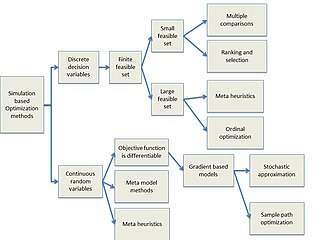Two-stage problems
The basic idea of two-stage stochastic programming is that (optimal) decisions should be based on data available at the time the decisions are made and cannot depend on future observations. The two-stage formulation is widely used in stochastic programming. The general formulation of a two-stage stochastic programming problem is given by:
where is the optimal value of the second-stage problem
The classical two-stage linear stochastic programming problems can be formulated as
where is the optimal value of the second-stage problem
In such formulation is the first-stage decision variable vector, is the second-stage decision variable vector, and contains the data of the second-stage problem. In this formulation, at the first stage we have to make a "here-and-now" decision before the realization of the uncertain data , viewed as a random vector, is known. At the second stage, after a realization of becomes available, we optimize our behavior by solving an appropriate optimization problem.
At the first stage we optimize (minimize in the above formulation) the cost of the first-stage decision plus the expected cost of the (optimal) second-stage decision. We can view the second-stage problem simply as an optimization problem which describes our supposedly optimal behavior when the uncertain data is revealed, or we can consider its solution as a recourse action where the term compensates for a possible inconsistency of the system and is the cost of this recourse action.
The considered two-stage problem is linear because the objective functions and the constraints are linear. Conceptually this is not essential and one can consider more general two-stage stochastic programs. For example, if the first-stage problem is integer, one could add integrality constraints to the first-stage problem so that the feasible set is discrete. Non-linear objectives and constraints could also be incorporated if needed. [5]
Distributional assumption
The formulation of the above two-stage problem assumes that the second-stage data is modeled as a random vector with a known probability distribution. This would be justified in many situations. For example, the distribution of could be inferred from historical data if one assumes that the distribution does not significantly change over the considered period of time. Also, the empirical distribution of the sample could be used as an approximation to the distribution of the future values of . If one has a prior model for , one could obtain a posteriori distribution by a Bayesian update.
Discretization
To solve the two-stage stochastic problem numerically, one often needs to assume that the random vector has a finite number of possible realizations, called scenarios, say , with respective probability masses . Then the expectation in the first-stage problem's objective function can be written as the summation:
and, moreover, the two-stage problem can be formulated as one large linear programming problem (this is called the deterministic equivalent of the original problem, see section § Deterministic equivalent of a stochastic problem).
When has an infinite (or very large) number of possible realizations the standard approach is then to represent this distribution by scenarios. This approach raises three questions, namely:
- How to construct scenarios, see § Scenario construction;
- How to solve the deterministic equivalent. Optimizers such as CPLEX, and GLPK can solve large linear/nonlinear problems. The NEOS Server, [6] hosted at the University of Wisconsin, Madison, allows free access to many modern solvers. The structure of a deterministic equivalent is particularly amenable to apply decomposition methods, [7] such as Benders' decomposition or scenario decomposition;
- How to measure quality of the obtained solution with respect to the "true" optimum.
These questions are not independent. For example, the number of scenarios constructed will affect both the tractability of the deterministic equivalent and the quality of the obtained solutions.





















































































































































